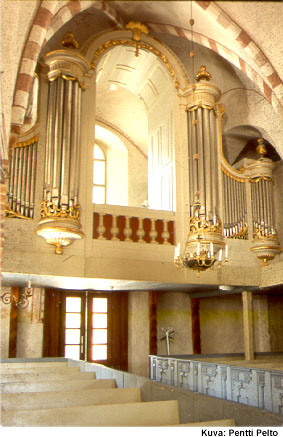
|
HISTORICAL ORGANS IN FINLAND 
Nauvo Church- Schwan, Olof 1791
- 12 stops, 1 manual and pull-down pedal
- mechanical action and mechanical stop action
The medieval Nauvo Church is known to have had an organ as early as in the 17th century, but the present organ was built by Olof Schwan of Sweden in 1791. It originally had one manual and pull-down pedals, and it was built in the loft above the main entrance. In 1878, Jens Alexander Zachariassen made alterations that were then considered timely, adding a second manual and pedal. He also made minor changes to the disposition of Manual I. In this guise, the organ saw a further century of service, until the brothers Moberg of Sweden repaired the instrument in 1976, restoring Schwan’s disposition to Manual I. The Nauvo organ is the largest preserved 18th-century organ in Finland, and the only one that has been restored.
Appearance
The organ has an unusual dual structure with the typical aperture façade that goes with it. The two halves of the organ are mounted on the parapet of the low loft, and they are joined in their upper parts with an arch. The organ thus frames a window in the rear wall. The façade halves consist of two round towers and a flat between them, topped with an arch. All the pipes in the large towers belong to Principal 8’, as do the inner pipes in the small towers. The outer pipes of the latter, like the pipes in the middle flat, are dummies. The façade pipes are surrounded with carved decorations both above and around their feet. The façade is soft and dynamic in its design because of the prominence of curves.
The main division of the organ is placed behind the façade halves, and the console is between them. The second manual and pedal added later are housed to the right of the organ in the aisle of the church, almost completely out of sight.
Technical features
The chests are lamellar sponselled slider chests; their internal and external components are amply dimensioned, reflecting the new artistic ambitions of the era of their building. A similar feature is the touch, which is quite heavy due to the rather large valves used. The chests are placed very low, only about one metre off the floor. This ensures the uninhibited transmission of the sound of the instrument around the rather low church.
The console built by Zachariassen has two manuals and a pedal. The action is also largely by Zachariassen. Indeed, there are two stylistic layers clearly visible in the instrument. Manual I is late 18th-century, while the console, action and Manual II are late 19th-century.
Musical properties
The disposition for Manual I includes not only a full set of Principal stops but a remarkable number of other 8’ stops and no fewer than three reed stops. The flue stops are broad and solid in sound, yet also clear and bright, even a bit shrill. The reed stops are not particularly soloist; their sound is designed to blend with the flue stops. The solid bass underlines the lowest notes in the texture, which is important for chorale accompaniment. The overall sound is grand, broad and coherent. The touch emphasizes and highlights the properties of the sound. The division of a number of stops into bass and treble halves makes it possible to play a solo and accompaniment on a single manual.
In the Gustavian era [the late 18th century], organs acquired a broader and more massive sound than before. The Nauvo organ shows the trend that was to strengthen and culminate in the 19th century. The importance of volume in organ music grew, whereas the tonal colour variety ideal waned. Manual II, built in 1878, contains quieter and more poetic tones.
Disposition
Manual I C-f3 | Manual II C-f3 | Pedal C-d1 |
Principal 8’ | Rörflöjt 8’ (1878) | Subbas 16’ (1878) |
Borduna 16’ | Principal 4’ (1976) | Principal 8’ (1878) |
Flagflöjt 8’ | | |
Kvintadena 8’ | | |
Oktava 4’ | | |
Flöjt 4’ | | |
Kvinta 2 2/3’ | | |
Oktava 2’ | | |
Scharf 3 x | | |
Trumpet 16’ | | |
Trumpet 8’ B/D | | |
Trumpet 4’ B | | |
Vox virginea 8’ D | | |
|
|
|
Original compass of Manual I was C-d3 and that of the pull-down pedals | | |
| | |
| | |
| | |
| | |
| | |
| | |
| | |
| | |
| | |
| | |
| | |
| | |
|